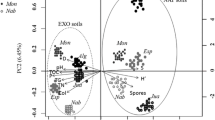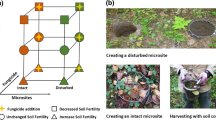Abstract
We conducted this study to explore limitations for the establishment of mycorrhizal associations in disturbed areas of the tropical dry ecosystem in the Chamela region of Jalisco, Mexico. Specifically, we: (1) assessed the diversity and composition of arbuscular mycorrhizal fungal (AMF) communities through spore morphospecies identification in three common land uses (primary forest, secondary forest, and pasture), (2) tested the inoculum potential of the AMF communities and the effect of water stress on the establishment of mycorrhizal associations in seedlings of various plant species, and (3) explored the importance of AMF community composition on early seedling development. Soil and root samples were taken from 15 random points in each of three plots established in two primary forests, two 26-year-old secondary forests, and two 26-year-old pastures. We expected that because of soil degradation and management, pastures would have the lowest and primary forests the highest AMF species richness. We found evidence for changes in AMF species composition due to land use and for higher morphospecies richness in primary forests than in secondary forests and pastures. We expected also that water stress limited plant and mycorrhizal development and that plants and AMF communities from secondary forests and pastures would be less affected by (better adapted to) water stress than those from the primary forest. We found that although all plant species showed biomass reductions under water stress, only some of the plant species had lower mycorrhizal development under water stress, and this was regardless of the AMF community inoculated. The third hypothesis was that plant species common to all land use types would respond similarly to all AMF communities, whereas plant species found mainly in one land use type would grow better when inoculated with the AMF community of that specific land use type. All plant species were however equally responsive to the three AMF communities inoculated, indicating that all plants established functionally compatible AMF in each community, with no preferences. The results suggest that early seedling growth and mycorrhizal development in secondary forests and pastures is not likely limited by diversity, quantity, or quality of mycorrhizal propagules but by the high temperature and water stress conditions prevailing at those sites.





Similar content being viewed by others
References
Aguilar-Fernández M (2000) Impacto de la roza-tumba y quema sobre la composición y actividad de los hongos micorrízicos arbusculares de una selva baja caducifolia. Master Thesis. Universidad Nacional Autónoma de México
Al-Karaki G, McMichael B, Zak J (2004) Field response of wheat to arbuscular mycorrhizal fungi and drought stress. Mycorrhiza 14:263–269 doi:10.1007/s00572-003-0265-2
Allen EB, Rincón E, Allen MF, Pérez-Jimenez A, Huante P (1998) Disturbance and seasonal dynamics of mycorrhizae in a tropical deciduous forest in Mexico. Biotropica 30:261–274 doi:10.1111/j.1744-7429.1998.tb00060.x
Allen EB, Allen MF, Egerton-Warburton L, Corkidi L, Gómez-Pompa A (2003) Impacts of early- and late-seral mycorrhizae during restoration in seasonal tropical forest. Ecol Appl 13:1701–1717 doi:10.1890/02-5309
Allen MF, Allen EB, Gómez-Pompa A (2005) Effects of mycorrhizal and nontarget organisms on restoration of a sesonal tropical forest in Quintana Roo, Mexico: factors limiting tree establishment. Restor Ecol 13:325–333 doi:10.1111/j.1526-100X.2005.00041.x
Alvarez-Santiago SA (2002) Efecto de la perturbación en la interacción micorrízica vesículo-arbuscular en un ecosistema tropical estacional. Master Thesis. Universidad Nacional Autónoma de México
Asbjornsen H, Montagnini F (1994) Vesicular-arbuscular mycorrhizal inoculum potencial affects the growth of Stryphenodendron microstachyum seedlings in a Costa Rican humid tropical lowland. Mycorrhiza 5:45–51 doi:10.1007/BF00204019
Augé RM (2001) Water relations, drought and vesicular-arbuscular mycorrhizal symbiosis. Mycorrhiza 11:3–42 doi:10.1007/s005720100097
Borrego-Kim S (1999) Efecto de las micorrizas arbusculares en el crecimiento de plántulas de especies arbóreas en una selva baja caducifolia. Bachelor Thesis, Universidad Nacional Autónoma de México
Brundrett M, Melville L, Peterson L (eds) (1994) Methods in mycorrhizal research. Mycologue Publications, Univ. of Guelph, Ontario, Canada
Burgos A (2004) Estrategia para el abordaje ecosistémico de una investigación en restauración ecológica, aplicada al caso del bosque tropical seco de la región de Chamela. Ph. D. Thesis. Universidad Nacional Autónoma de México
Burgos A, Maass JM (2004) Vegetation change associated with land-use in tropical dry forest areas of Western Mexico. Agric Ecosyst Environ 104:475–481 doi:10.1016/j.agee.2004.01.038
Cotler H, Durán E, Siebe C (2002) Caracterización morfo-edafológica y calidad de sitio de un bosque tropical caducifolio. In: Noguera F, Vega J, García-Aldrete A, Quesada M (eds) Historia Natural de Chamela. Instituto de Biología, Universidad Nacional Autónoma de México, DF Mexico, pp 17–79
Cuenca G, Andrade Z, Escalante G (1998) Diversity of glomalean spores from natural, disturbed, and revegetated communities growing on nutrient-poor tropical soils. Soil Biol Biochem 30:711–719 doi:10.1016/S0038-0717(97)00191-0
Fischer CR, Janos DP, Perry DA, Linderman RG, Sollins P (1994) Mycorrhiza inoculum potentials in tropical secondary succession. Biotropica 26:369–377 doi:10.2307/2389230
García-Oliva F, Camou A, Maass JM (2002) El clima de la Región Central de la costa del Pacífico Mexicano. In: Noguera F, Vega J, García-Aldrete A, Quesada M (eds) Historia Natural de Chamela. Instituto de Biología, Universidad Nacional Autónoma de México, DF Mexico,, pp 3–10
Gerdemann JW, Nicolson TH (1963) Spores of mycorrhizal Endogone species extracted from soil by wet-sieving and decanting. Trans Br Mycol Soc 46:235–244
Guadarrama-Chávez P, Camargo-Ricalde SL, Hernández-Cuevas L, Castillo-Argüero S (2007) Los hongos micorrizógenos arbusculares de la región de Nizanda, Oaxaca, Mexico. Bol Soc Bot Mex 81:133–139
Guadarrama-Chávez P, Castillo-Argüero S, Ramos-Zapata JA, Camargo-Ricalde SL, Alvarez-Sánchez FJ (2008) Propagules of arbuscular mycorrhizal fungi in a secondary dry forest of Oaxaca Mexico. Int J Trop Biol 56:269–277
Huante P, Rincón E, Allen EB (1993) Effect of vesicular-arbuscular mycorrhizae on seedling growth of four tree species from the tropical deciduous forest in Mexico. Mycorrhiza 2:141–145 doi:10.1007/BF00203860
Janos DP (1980) Mycorrhizae influence tropical succession. Biotropica 12:56–64 doi:10.2307/2388157
Johnson NC, Wedin DA (1997) Soil carbon, nutrients, and mycorrhizae during conversion of dry tropical forest to grassland. Ecol Appl 7:171–182 doi:10.1890/1051-0761(1997)007[0171:SCNAMD]2.0.CO;2
Kennard DK, Gould K, Putz FE, Fredericksen TS, Morales F (2002) Effect of disturbance intensity on regeneration mechanisms in a tropical dry forest. For Ecol Manag 162:197–208
Lott EJ (1993) Annotated checklist of the vascular flora of the Chamela Bay Region, Jalisco, Mexico. Occas Pap Calif Acad Sci 148:1–60
Lott EJ (2002) Lista anotada de las plantas vasculares de Chamela-Cuixmala. In: Noguera F, Vega J, García-Aldrete A, Quesada M (eds) Historia Natural de Chamela. Instituto de Biología, Universidad Nacional Autónoma de México, DF Mexico, pp 99–136
Maass JM (1995) Conversion of tropical dry forest to pasture and agriculture. In: Bullock SH, Mooney HA, Medina E (eds) Seasonally dry tropical forests. Cambridge University Press, Cambridge, p 468
Maass JM, Jaramillo V, Martínez-Yrízar A, García-Oliva F, Pérez-Jiménez A, Sarukhán J (2002) Aspectos funcionales del ecosistema de selva baja caducifolia en Chamela, Jalisco. In: Noguera F, Vega J, García-Aldrete A, Quesada M (eds) Historia Natural de Chamela. Instituto de Biología, Universidad Nacional Autónoma de México, DF Mexico 525–542
Magurran AE (1988) Ecological diversity and its measurement. Princeton University Press, Princeton, NJ
McGonigle TP, Miller MH, Evans DG, Fairchild GL, Swan JA (1990) A new method which gives an objetive measure of colonization of roots by vesicular-arbuscular mycorrhizal fungi. New Phytol 115:495–501 doi:10.1111/j.1469-8137.1990.tb00476.x
Picone C (2000) Diversity and abundance of arbuscular-mycorrhizal fungus spores in tropical forest and pasture. Biotropica 32:734–750 doi:10.1646/0006-3606(2000)032[0734:DAAOAM]2.0.CO;2
Romero-Duque LP, Jaramillo VJ, Pérez-Jiménez A (2007) Structure and diversity of secondary tropical dry forests in Mexico, differing in their prior land-use history. For Ecol Manag 253:38–47
Ryan MH, Ash JE (1996) Colonization of wheat in southern New South Wales by vesicular-arbuscular mycorhhizal fungi is significantly reduced by drought. Aust J Exp Agric 36:563–569 doi:10.1071/EA9960563
Schenck NC, Pérez Y (1990) Manual for the identification of VA Mycorrhizal fungi. Synergistic Publications, USA
Smith SE, Read DJ (1997) Mycorrhizal symbiosis. Academic, UK
Trejo I, Dirzo R (2000) Deforestation of seasonally dry tropical forest: a national and local analysis in Mexico. Biol Conserv 94:133–142 doi:10.1016/S0006-3207(99)00188-3
Acknowledgments
We are grateful to Arturo Jiménez Martínez, Salvador Araiza, Eloy Araiza, Abel Verduzco, Gustavo Verduzco, and Ana Lidia Sandoval Pérez for valuable technical and field assistance. Mr. Ramiro Peña and Araiza family kindly allowed us to work in their pastures and secondary forests. This research was supported by Programa de Apoyo a Proyectos de Investigación Científica e Innovación Tecnológica, Universidad Nacional Autónoma de México (PAPIIT- IN222005).
Author information
Authors and Affiliations
Corresponding author
Electronic supplementary material
Below is the link to the electronic supplementary material.
Table S1
Brief description of AMF morphospecies not matching a published description and found in field samples and propagation pots from two primary forests (PF), two secondary forests (SF), and two pastures (P) of the tropical dry ecosystem in the Chamela region of Jalisco, Mexico. (Doc 445 KB)
Rights and permissions
About this article
Cite this article
Gavito, M.E., Pérez-Castillo, D., González-Monterrubio, C.F. et al. High compatibility between arbuscular mycorrhizal fungal communities and seedlings of different land use types in a tropical dry ecosystem. Mycorrhiza 19, 47–60 (2008). https://doi.org/10.1007/s00572-008-0203-4
Received:
Accepted:
Published:
Issue Date:
DOI: https://doi.org/10.1007/s00572-008-0203-4




